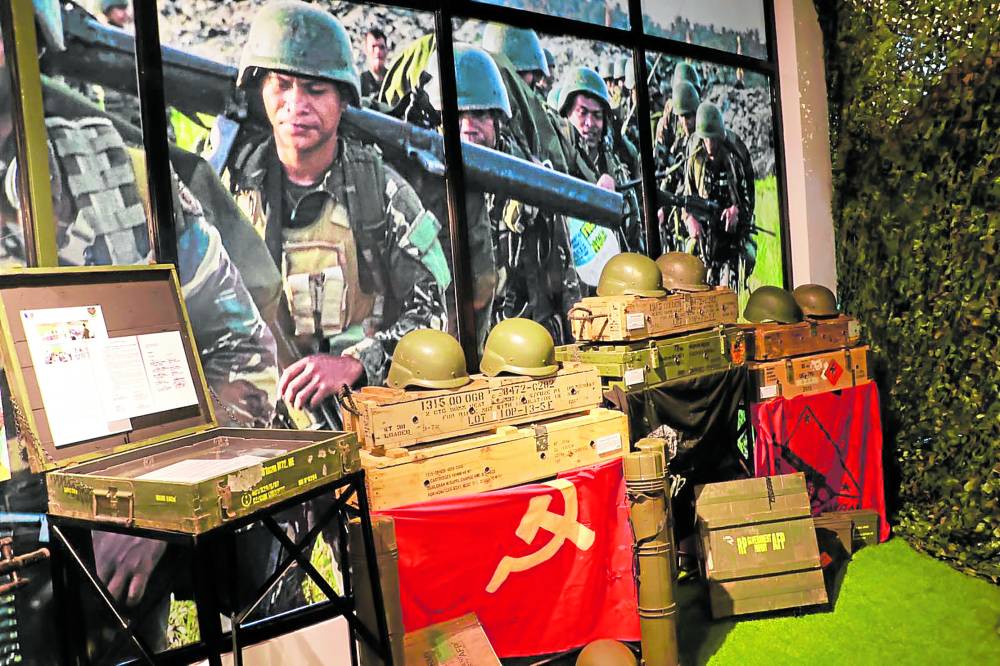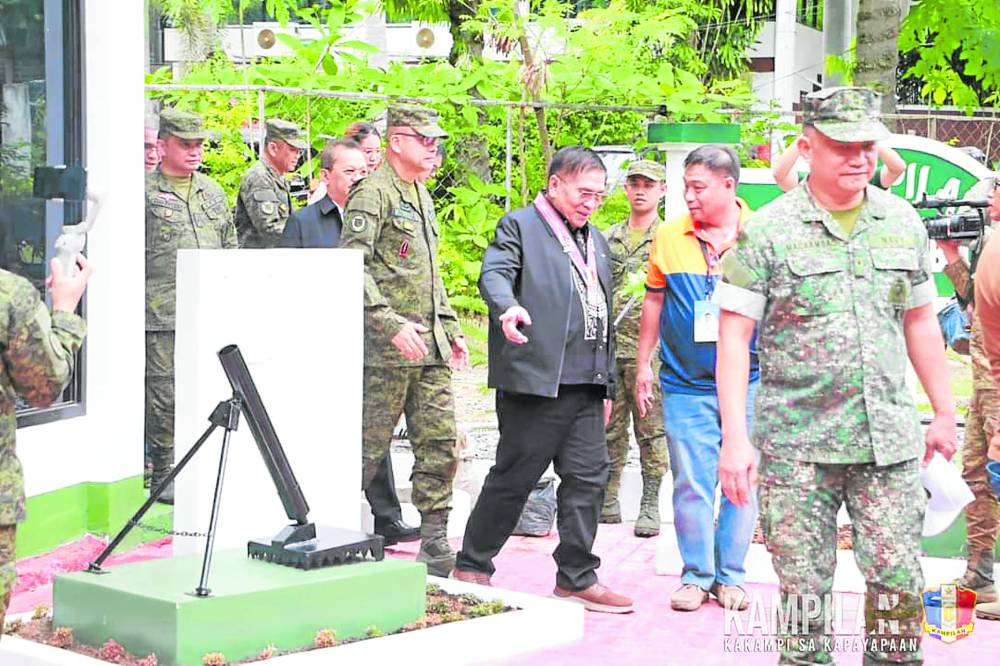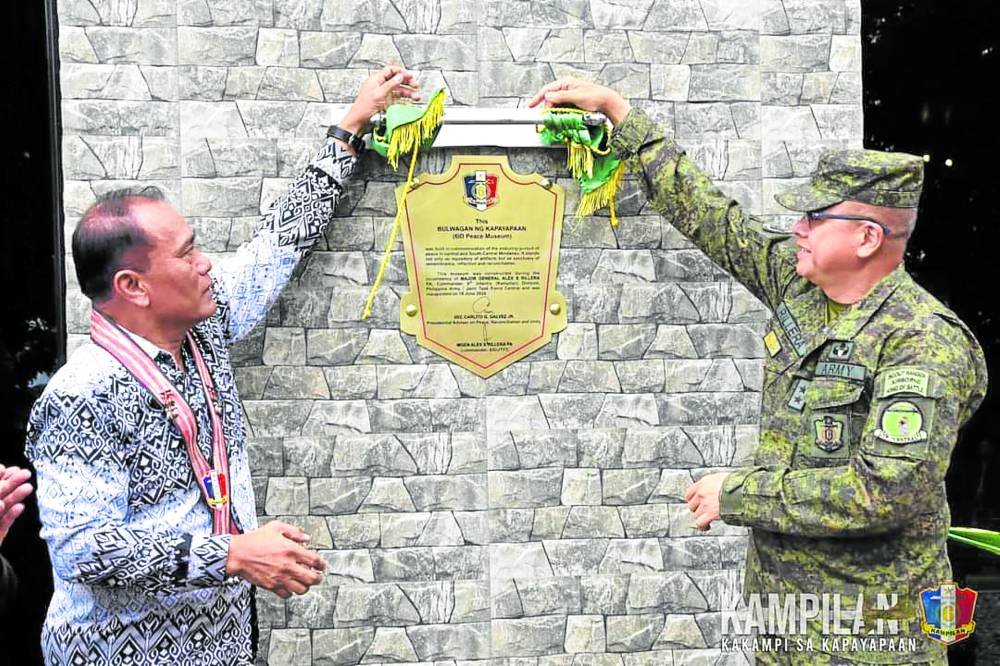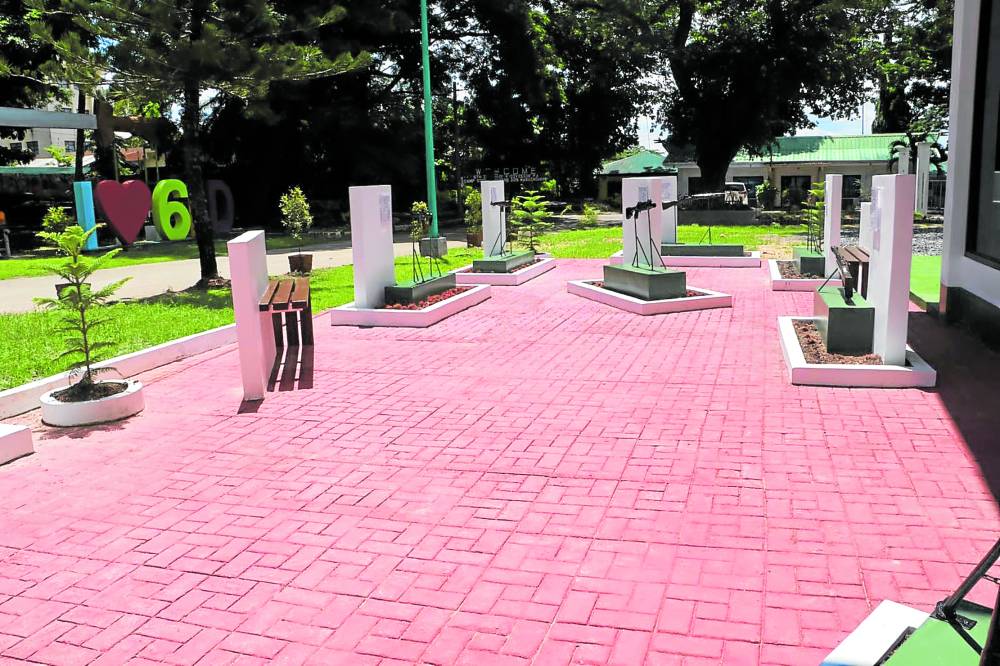Peace museum rises in center of war

REMINDERS OF CONFLICT At Camp Siongco in Maguindanao del Norte, Army helmets and communist banners are displayed inside the peace museum of the Army’s 6th Infantry Division (6ID) and deactivated weapons outside. —photos courtesy of 6ID
CAMP SIONGCO, MAGUINDANAO DEL NORTE, Philippines — In a sign of a radically changing time, a peace museum now stands inside the camp of the Army’s 6th Infantry Division (6ID) here, the nucleus of the government’s protracted military campaign against Moro separatists in Mindanao.
Officially called the Bulwagan ng Kapayapaan (Hall of Peace) and inaugurated on June 19, the facility is one of 6ID’s platforms for engaging the public on the need to strengthen efforts to sustain the gains of peace achieved in central Mindanao communities.
READ: BARMM coalition to implement all peace pacts if they win 2025 polls
It was built “to capture and portray the grim realities of armed conflict” so that its visitors “are inspired to strive for peace, promote reconciliation and foster unity for the welfare of future generations,” according to Maj. Gen. Alex Rillera, 6ID commander, who conceived of the idea of a peace museum within the camp.
The museum seeks to “honor the past, promote understanding and inspire a future of peace,” Rillera added.
Article continues after this advertisementLocated in Datu Odin Sinsuat town, Maguindanao del Norte, the 6ID headquarters sits at the heartland of the Moro struggle for self-determination.
Article continues after this advertisementHence, it has become the centrum for planning and overseeing the conduct of military campaigns to suppress the four-decade armed rebellion—first by the Moro National Liberation Front (MNLF) and then the Moro Islamic Liberation Front (MILF)—founded on a strong longing by the Bangsamoro people to secede from the country and establish an independent state.
War machine
Established in 1987, the 6ID, on the one hand, stood as an instrument of a defiant government imposing its will on a beleaguered people to avoid dismemberment of its territory. On the other hand, a large section of the Moro people in Maguindanao regarded it as a symbol of occupation.
The winds began to change in 1996 when the government and the MNLF forged the Final Peace Agreement.
Although the MILF did not join the accord and vowed to continue the rebellion in pursuit of further political concessions, it declared that a negotiated settlement was the best way to end the war that was estimated to have claimed the lives of over 120,000 people and set back progress in the region.
Began in 1997, the protracted negotiations with the MILF concluded with the Comprehensive Agreement on the Bangsamoro in 2014.
Under the landmark peace deal, the MILF agreed to drop its separatist bid in exchange for, among others, redoing the Moro autonomy setup by giving it greater governance powers, conceding to it a fixed share in national revenues, and ensuring funding support for rehabilitation of war-torn communities and decommissioning of some 40,000 combatants and their weapons.
Other key aspects of the deal are recognition of Moro identity and acknowledgment of historical injustices through succession of government actions and policies that disfavored and discriminated against them as a people.
The end of the Moro rebellion leaves the 6ID fighting against the dwindling forces of the communist insurgency in southern Mindanao and local affiliates of the transnational terror group Islamic State.

Maguindanao del Norte Gov. Abdulraof Macacua passes by a deactivated mortar that he, as a former Moro combatant, had to deal with as a guerrilla.
Peacemaking legacy
As with conflict, the 6ID also played a key role in peacemaking. For one, it is the main flank for upholding the joint ceasefire between the government and the MILF. A number of those who led the government’s ceasefire panel eventually served as 6ID commanders, such as Rodolfo Garcia and Carlito Galvez.
The ceasefire was a significant factor in reducing provocations and clashes between MILF fighters and government forces, providing and enabling an atmosphere for negotiations.
After his retirement from military service, Garcia went on to become a member of the government peace negotiating panel, eventually heading it.
Galvez went on to become the 50th chief of staff of the Armed Forces of the Philippines, and headed the Office of the Presidential Adviser on Peace, Reconciliation and Unity since 2018.
With the ebb of hostilities in the run-up to a peace accord, the 6ID was at the forefront of confidence-building efforts toward the Moro guerrillas and the public at large which is essential in transforming relations that used to be shaped by war and conflict.
Under the leadership of Rey Ardo during the crucial times of the peace process in 2012, he allowed the camp to host backchannel meetings between MILF and government negotiators, helping iron out potentially contentious issues in the formal negotiations facilitated by Malaysia.
Ardo continues to serve the peace process today as member of the Independent Decommissioning Body tasked with putting “beyond use” the MILF’s forces and their weapons.
This legacy is what Rillera wanted passed on to the youth through the museum.
“For a soldier, peace is the end of unnecessary conflict [wherein] man is pitted against man in a never ending cycle of fighting. This journey to peace is long and hard fought, it needs patience, it needs grit and determination … [it] is not done alone but rather it ought to be done as a collective effort,” he said.

OPEN TO THE PUBLIC Undersecretary for Bangsamoro Transformation David Diciano (left) and Maj. Gen. Alex Rillera, 6ID commander, unveil a museum marker to signal its opening to the public.
Role of youth
“The youth of today are the ones to uphold the peace of tomorrow. And with the help of our museum, may the youth have at their disposal the lessons of the past, the yearnings of the present and the bright hope and vision of tomorrow,” he added.
Curated by visual artist Leonardo Rey Cariño, the museum has three galleries.
The “Shadows of Conflict” gets visitors to immerse into the dark side of armed conflict through compelling photographs, videos, artifacts and narratives of significant military campaigns that depict the devastation in civilian communities.
The “Seeds of Hope” contain stories of resilience, acts of bravery and efforts toward reconciliation, showcasing defiant hope that eventually conquers adversity.
The “Blooms of Peace” shows images of progress such as the completion of longed infrastructure projects in communities, delivery of social services, as well as the start of the healing of the scars of conflict.
Side by side with these, the timeline of the Bangsamoro struggle is also shown, as well as a chronological overview of the history of the 6ID, especially its evolution, its many critical missions and contributions to the region.
Outside the museum is a “Garden of Peace” that displays carcasses of surrendered armaments. The spot aims to tell a message that weapons of war do not resolve conflicts.
The museum’s building was funded by the Bangsamoro Autonomous Region in Muslim Mindanao government through the support of Member of Parliament Susana Anayatin who chairs the 6ID’s multisectoral advisory group.
“I always believe that peace and development are two sides of the same coin. We cannot have development without peace, and we cannot sustain peace without development,” Rillera said.
